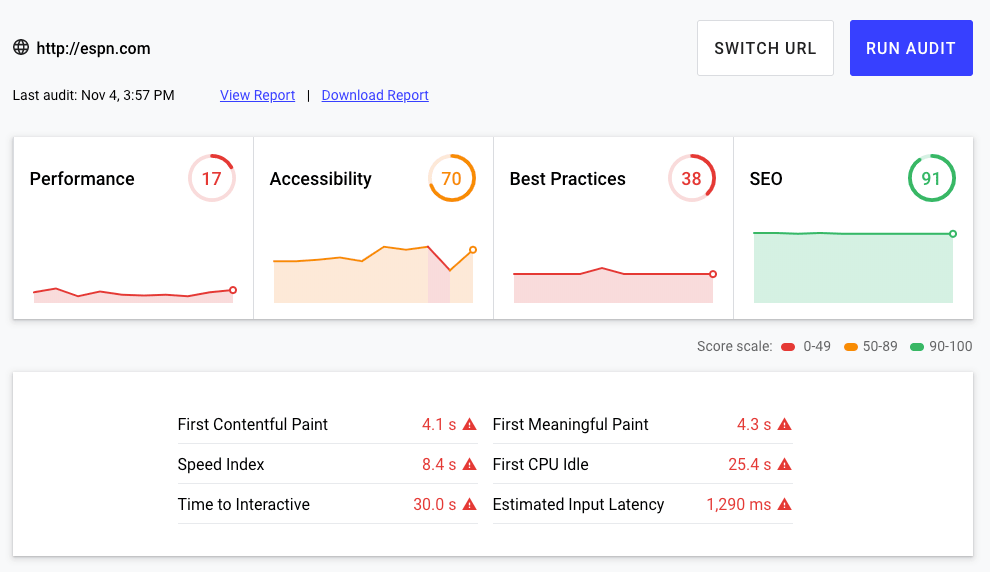Note: This blog was updated December 2024.
If you’re actively working on your SEO, you’ve probably run your site through Google’s Lighthouse tester over at web.dev.

'Links Do Not Have Descriptive Text': Fixing a Common SEO Issue
One common error that Lighthouse throws – particularly on older sites – is “Links Do Not Have Descriptive Text.” You’ll see it under the “SEO” section of your Lighthouse audit report.
This guide will break down for you:
- What Lighthouse is
- How to drill into
Lighthouse - What “Links Do Not
- Have Descriptive Text” means
- How to fix “Links Do Not Have Descriptive Text”
- How to confirm you’re error-free
Let’s start at the very beginning, with Lighthouse itself.
What Is Google Lighthouse?

Lighthouse is an open-source, automated tool that audits web pages for a number of usability and performance factors. Basically, it’s the more capable successor to PageSpeed Insights, Google’s old performance measurement tool.
You can run Lighthouse audits in a number of ways. These include:
- Over at web.dev/measure (the most common way)
- With a Chrome extension
- In Chrome DevTools
- From the command line
- As a Node module
No matter how you generate your report, you’re looking for four top-line numbers and drilldown details on each. These are:
- Performance, which focuses on page speed, load time and ways to improve both
- Accessibility, which focuses on ARIA compliance to make the web better for people with disabilities
- Best practices, which focuses on potential security vulnerabilities and code issues
- SEO, which focuses on user experience elements that Google likely takes into account in where it ranks a site
The ideal is a green (90+) score in each of the four areas. Full disclosure: I’ve never seen this. Getting the first three above 75 (you should easily max out SEO) is a pretty nice accomplishment.
Within each area, you’ll see a list of high-, medium- and low-priority fixes. This is where we’ll eventually find “Links Do Not Have Descriptive Text.”
It’s important to note that Lighthouse usually evaluates the mobile version of a site using an emulated Galaxy Nexus 5X smartphone. This is why mobile speed is so important to your site. Google is using an Android device to determine if your site, well, sucks. If it’s slow on mobile, it’s going to look slow to Google – even if humans hardly ever hit it on phones.
How to Drill Into Lighthouse Results
The cool thing about Lighthouse is that it doesn’t just tell you about your problems. It helps you fix them.
Within each of the four main areas, you’ll find Opportunities and Diagnostics.

These show you what Lighthouse uncovered, and you can open each to see details and some prescribed fixes.
In Performance, for example, it’s common to find a list of images to optimize. Accessibility identifies images without [alt] attributes. Best Practices loves to tell you that you’re using an old version of jQuery.
And a lot of sites throw the error “Links Do Not Have Descriptive Text.”
What Is "Links Do Not Have Descriptive Text"?
Basically, Google wants every button and link on your site to be hyper-explicit about what it’s going to do for the user. Here’s how they describe it:
“In general, the link text should clearly indicate to users what type of content they’ll get if they click the link.”
In other words, the days of the “Learn More” button are over.
You’ll find this error in the SEO section of your Lighthouse report.
Here’s a bad link that would flag “Links Do Not Have Descriptive Text”:
<p><a href="https://altitudemarketing.com/blog/sustainable-seo-strategy/">Click here</a> to see our post on sustainable SEO.</p>
Here’s a good link to the same content:
<p><a href="https://altitudemarketing.com/blog/sustainable-seo-strategy/">Sustainable SEO</a> is all about delivering a fantastic user experience.</p>
See the difference?
One link is – to Google’s eyes – about clicking here. There’s no context in that. The other is an article about sustainable SEO linked from the words sustainable SEO. Much clearer, and much better.
The first example would throw the red flag in your Lighthouse score. That means Google is finding an issue with your user experience. And since Google is all about user experience, that could affect your SEO.
The second example is a good link. It’s fine for Lighthouse, and fine for Google. Don’t be lazy with your links.
Which Words Are Out?
According to Google’s Developer Tools, Lighthouse will look for and flag these terms when used as descriptions for links or buttons:
- click here
- click this
- go
- here
- this
- start
- right here
- more
- learn more
See the pattern? All of those apply to pretty much every link in the world. And if you apply to every link in the world, you’re not descriptive.
Fixing the Descriptive Text Error
Fixing “Links Do Not Have Descriptive Text” is pretty gosh darn easy: Just replace your link descriptions.
Lighthouse will tell you which links on the page are bad. Replace the words in the list above with something that is:
- Descriptive
- On topic
- Short and sweet
- Useful for the user
In a lot of cases, this means changing sentence structure like the code examples above. Drop “click here” and “go” from your vocabulary and just put your links in context.
If you have buttons that read “Learn More,” find something better. If you don’t have anything better, do you really need the button?
Should You Panic and Tear Through Your Whole Site?
No.
“Links Do Not Have Descriptive Text” is not a critical website issue. Performance – particularly first contentful paint – is a much bigger deal. But you still want to remedy it if it comes up. If Google calls it poor UX, it’s poor UX.
Confirming You're Error-Free
The best way to confirm that you’ve fixed the descriptive text problem with your links is to simply run another Lighthouse audit. If the error disappears on your SEO report, you’re golden!
Key Takeaways
- Lighthouse is an excellent, intuitive tool for testing your website’s performance, accessibility, user-friendliness. All this adds up to sustainable SEO practices.
- You can access Lighthouse in many ways, but usually through web.dev/measure.
- A common error that Lighthouse returns is “Links Do Not Have Descriptive Text.” It does this because one or more of your links or buttons did not have any useful information for the user about what they get when they click.
- You can fix this error simply by changing the words in the link or button to something more descriptive.
- You can run another Lighthouse audit to confirm your fix.



